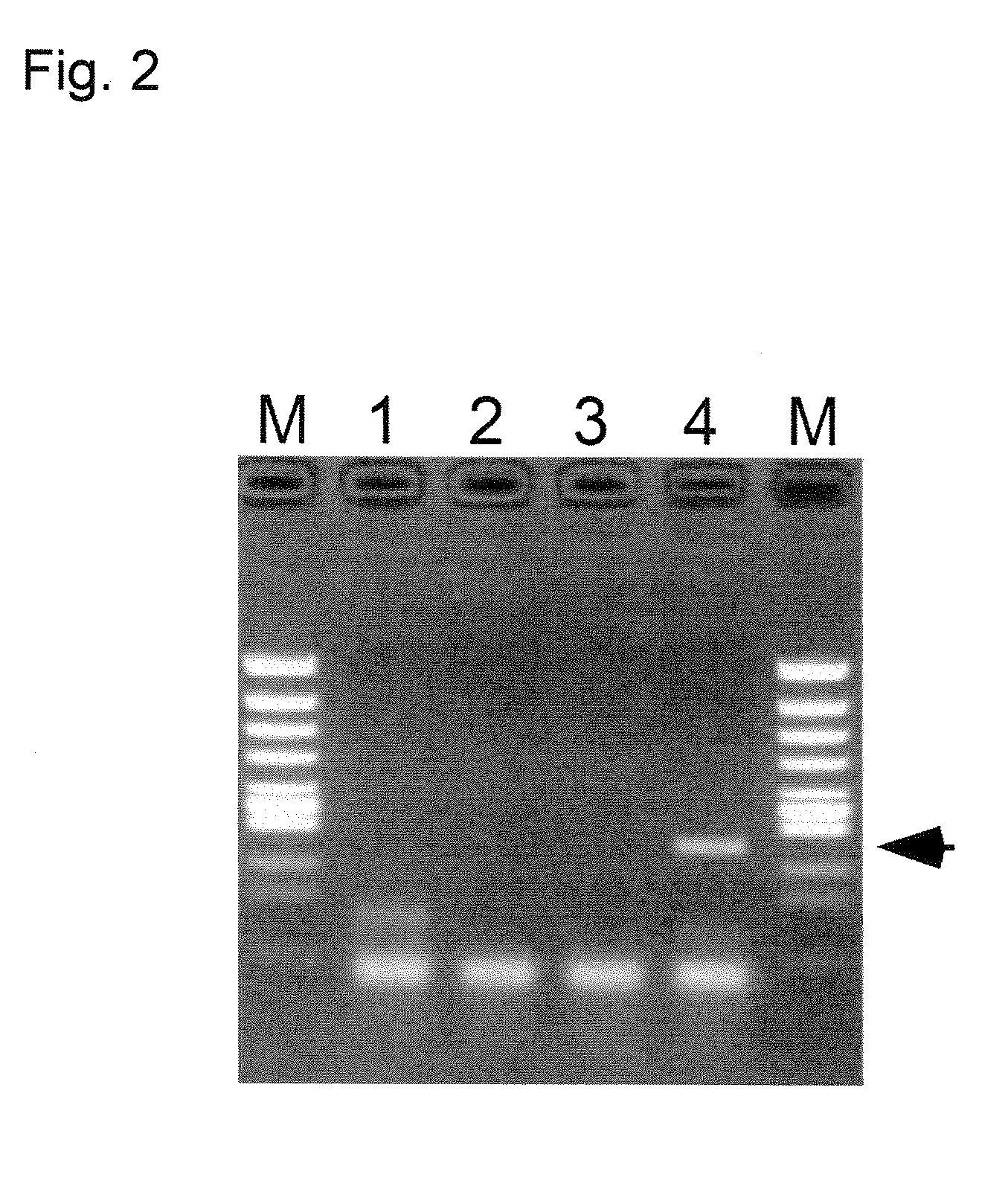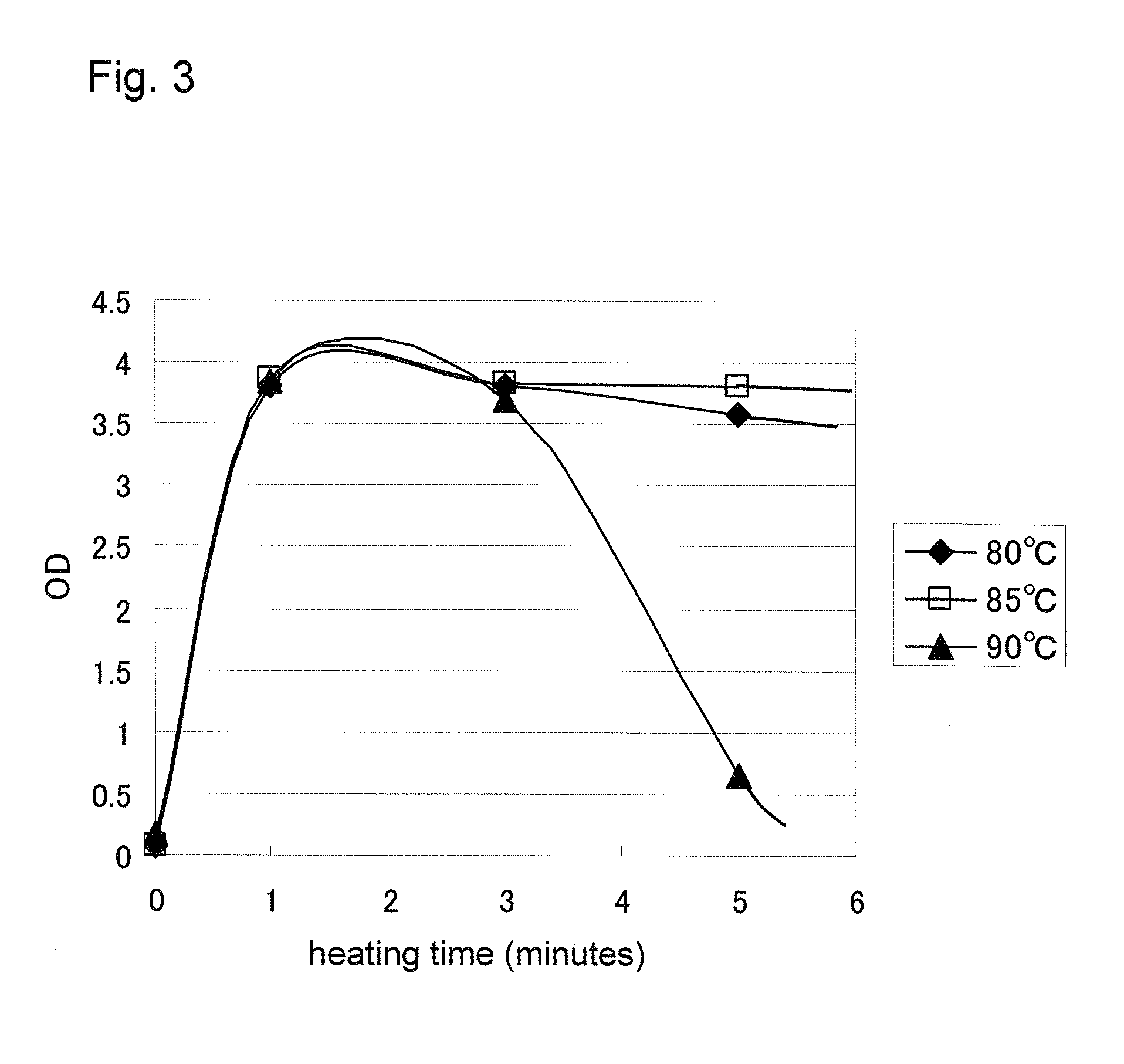RNA extraction method and RNA detection method
- Summary
- Abstract
- Description
- Claims
- Application Information
AI Technical Summary
Benefits of technology
Problems solved by technology
Method used
Image
Examples
example 1
[0201]In the present example, a model specimen obtained by adding an RNA-including body to human serum (comprising RNase) was used as a sample, and to this sample, distilled water (for comparison), a NaOH aqueous solution (for comparison), a DTT aqueous solution (for comparison), or a NaOH-DTT aqueous solution serving as a treating reagent of the present invention was added, and a heating treatment was conducted, and then RNA extraction was examined.
[0202]Concretely, as an RNA-including body, Armored RNA Hepatitis C Virus (Genotype 2b) Catalog #: 42011 made by Ambion was used. A model specimen in which equivalent amounts (v / v) of human serum and an Armored RNA Hepatitis C Virus solution was mixed was prepared as a sample. Four 0.5 mL tubes each charged with 4 μL of the specimen were prepared, and each tube was added with 16 μL of (1) distilled water (for comparison), (2) 10 mM NaOH aqueous solution (for comparison), (3) 10 mM DTT aqueous solution (for comparison), or (4) aqueous sol...
example 2
[0213]In the present example, four kinds of treated sample liquids obtained in Example 1 were subjected to RT-PCR in the same manner as in Example 1 after storing for 1 day under refrigeration, and storage stability of RNA after extraction was examined. Conditions of RT reaction, PCR reaction and electrophoresis are as same as those in Example 1. FIG. 2 shows an electrophoretogram of amplification products. In FIG. 2, M shows a result of a size marker (250 ng of φX174-RF DNA digested by HincII), 1, 2, 3 and 4 respectively show the results using distilled water (for comparison), 10 mM of a NaOH aqueous solution (for comparison), 10 mM of a DTT aqueous solution (for comparison), and 10 mM of a NaOH-10 mM DTT aqueous solution (treating reagent of the present invention).
[0214]FIG. 2 demonstrates that when the treating reagent of the present invention is used (Lane 4), 244 bp of an amplification product which is specific to HCV RNA (arrow in the drawing) is obtained even after lapse of o...
example 3
Influence of Temperature and Time of Heating Treatment (1)
[0216]To a 1.5 mL SARSTEDT tube, 100 μL of an HCV-positive (about 100 IU / mL) plasma specimen was dispensed, 50 μL of a PEG aqueous solution (HBV SOL A supplied with “Specimen treating reagent for Amplicor® HBV monitor” made by Roche Diagnostics K.K., the same applies also to Examples 4, 5, 6 and 7 below) was added and stirred. The mixture was centrifuged in a BenchTop microcentrifuge at 15000 rpm for 5 minutes, and the supernatant was removed. The remaining precipitate was added with 100 μL of aqueous solution comprising 12 mM of NaOH, 12 mM of DTT, and 6 μg / mL of heparin sodium as a treating reagent, stirred well on Vortex mixer, and incubated in the conditions as shown in the Table below. Immediately after heating, 50 μL of the treated sample liquid in the tube was mixed with 50 μL of Master mix of Amplicor® HCV v.2.0 kit prepared in another tube, and HCV signal (OD) was measured by GeneAmp9600 (Applied Biosystems) accordin...
PUM
| Property | Measurement | Unit |
|---|---|---|
| Temperature | aaaaa | aaaaa |
| Acidity | aaaaa | aaaaa |
| Temperature | aaaaa | aaaaa |
Abstract
Description
Claims
Application Information
 Login to view more
Login to view more - R&D Engineer
- R&D Manager
- IP Professional
- Industry Leading Data Capabilities
- Powerful AI technology
- Patent DNA Extraction
Browse by: Latest US Patents, China's latest patents, Technical Efficacy Thesaurus, Application Domain, Technology Topic.
© 2024 PatSnap. All rights reserved.Legal|Privacy policy|Modern Slavery Act Transparency Statement|Sitemap



